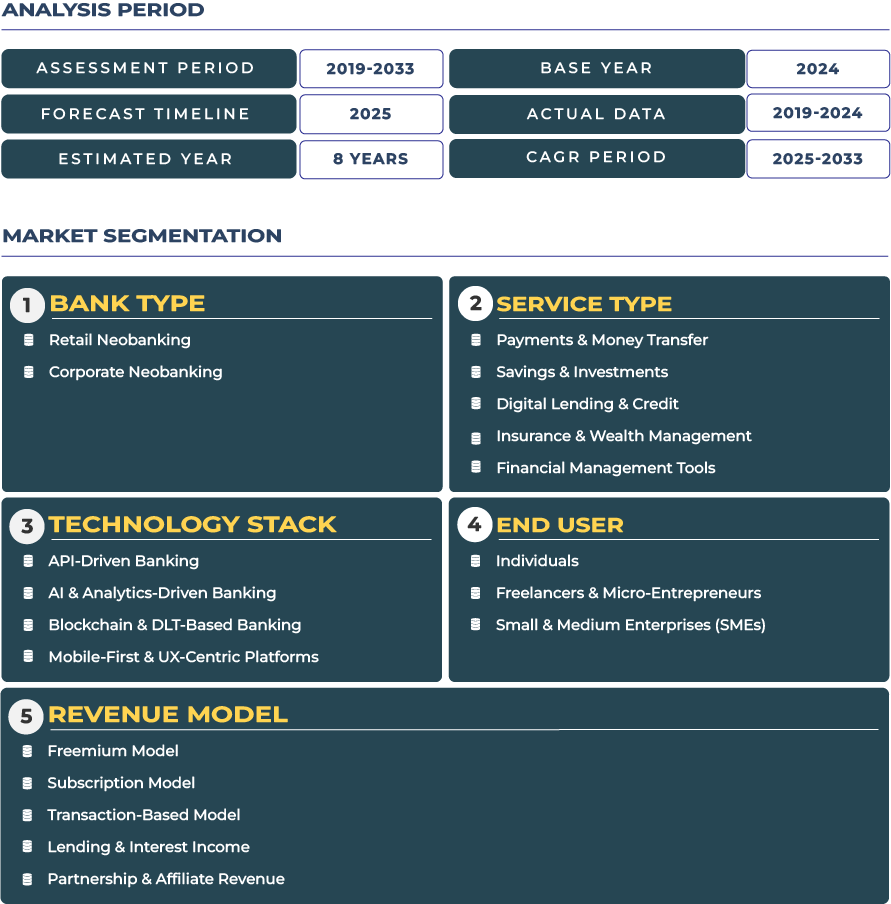Super-App Banking With CBDC Pilots Propel China Fintech Neobanking Platform Evolution
China unique fintech ecosystem—anchored in super-app architectures and e‑CNY-enabled digital rails—is a fertile ground for technology providers that design, develop and license digital-banking platforms and modular banking capabilities. These platform vendors supply virtual-account engines, embedded wallet modules, mini-program banking stacks and corporate-treasury integration for clients operating within the domestic market and beyond. The fintech neobanking market in China is forecast to reach USD 4,211.5 billion by 2033, reflecting a compelling CAGR of 30.8 % during the forecast period. Vendors able to integrate CBDC rails, in-app banking workflows and cross-border settlement modules will capture value as corporate wallets, gig-economy payouts and multi-channel digital banking accelerate. Regulatory shifts, geopolitical tension and domestic data-sovereignty mandates are elevating demand for modular platforms built on native rails. Technology providers offering licence-agnostic, API-first banking cores that support super-app embedding, digital-identity-based onboarding and e-CNY settlement are positioned to lead China fintech neobanking landscape.
China Fintech Neobanking Market: Platform Drivers, Emerging CBDC Opportunities, and Competitive Super-App Banking Strategies
Drivers & Restraints – Super-App Ecosystems, QR Interoperability, and e-CNY Pilots Boost Platform Vendor Growth Amid Regulatory Tightening
The China fintech neobanking market is expanding rapidly as technology providers deploy modular digital-banking platforms within super-app ecosystems such as WeChat, Alipay, and Meituan. These vendors enable banking functionality—virtual accounts, embedded wallets, and treasury micro-modules—directly inside mini-program environments. The nationwide rollout of QR payment interoperability and the ongoing pilot of the digital yuan (e-CNY) by the People’s Bank of China have accelerated opportunities for API-based neobanking stacks capable of supporting both retail and corporate use cases. Vendors offering real-time settlement, AI-based risk scoring, and digital-ID integration are capitalizing on this trend. However, platform growth faces challenges due to the ongoing fintech rectification campaigns and data-sharing constraints imposed by cybersecurity regulations. Vendor scalability is further impacted by platform-anchor dependency and domestic data-localization requirements. The players that embed compliance automation and distributed-ledger-ready infrastructure within their core modules are expected to sustain long-term growth under China evolving digital-finance governance.
Trends & Opportunities – Marketplace Supply-Chain Finance and e-CNY Payroll Solutions Reshape Platform Monetization Models:
Key trends shaping China fintech neobanking sector include the convergence of marketplace supply-chain finance (SCF) and embedded digital-banking infrastructure. Vendors are building modular SCF engines that integrate receivable-tokenization and dynamic discounting directly within B2B commerce platforms. The adoption of e-CNY payroll tools is another defining trend, as technology providers license wallet APIs and salary-disbursement modules compatible with central-bank digital currency rails. This shift not only enhances liquidity for enterprises but also creates monetization opportunities for banking-as-a-service platforms. In cities such as Shenzhen, Suzhou, and Chengdu—major pilot zones for the digital yuan—platform providers are integrating CBDC APIs for instant salary credits, merchant settlements, and automated expense reconciliation. The rise of sovereign-currency-linked APIs, coupled with enterprise-data partnerships, positions vendors to extend their modular architectures across Asia and Belt-and-Road partner economies.
Competitive Landscape – Platform Anchors, Compliance-First Strategies, and Super-App Collaborations Define Market Differentiation
China fintech neobanking landscape is dominated by technology vendors embedding banking modules within super-app ecosystems while adhering to stringent compliance frameworks. Companies such as Ant Group and Tencent Financial Technology continue to expand their partnerships with local banking-technology developers to advance e-CNY compatibility and mini-program banking functionality. Competitive advantage increasingly depends on two vendor strategies: platform-anchor data integration—which enables personalized credit, savings, and commerce flows—and compliance-first frameworks ensuring regulatory alignment and operational longevity. Vendors integrating analytics-driven credit engines, sovereign-currency wallets, and hybrid treasury modules are capturing traction among enterprise clients and cross-border trade platforms. As China moves toward the next stage of CBDC commercialization, digital-banking technology providers able to deliver sovereign-ready, modular infrastructure with embedded settlement, scoring, and analytics will define the future of the country’s fintech neobanking market.







